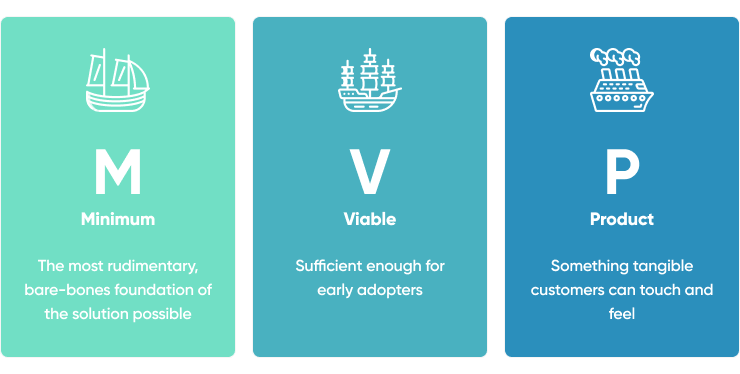Building a successful tech startup from scratch is a challenging and rewarding journey. It requires a combination of creativity, innovation, and strategic planning, as well as a willingness to take risks, adapt to changing market conditions, and learn from failure. In this article, we will cover some actionable steps to help you start and grow your own tech company.
1. Build an MVP the market wants
Building a successful tech startup requires a lot of hard work and dedication. However, your first step in launching a tech startup should be to create a Minimum Viable Product (MVP). An MVP is a version of your product that has the core features and functionality that solve the problem you are addressing for your target customers.

An MVP allows you to test your product idea with real users and get feedback on what works and what doesn’t. It also helps you avoid wasting time and money on developing features that nobody wants or needs. To build an MVP, you need to do some market research and identify the main pain points and needs of your potential customers. You also need to define your value proposition and unique selling points that differentiate your product from existing solutions2.
2. Validate the solution with early adopters
Once you have an MVP, you need to validate it with early adopters. Early adopters are the people who are willing to try new products and give honest feedback. They are also the ones who can help you spread the word about your product and generate referrals.
To find early adopters, you can use various channels such as social media, online forums, blogs, podcasts, events, etc. You can also leverage your personal and professional network and ask for introductions or recommendations. The goal is to reach out to people who have the problem you are solving and who are interested in your solution.

When you interact with early adopters, you need to collect as much data and feedback as possible. You can use tools such as surveys, interviews, analytics, etc. to measure how they use your product, what they like and dislike, what features they request, what challenges they face, etc. You also need to track key metrics such as user acquisition, retention, engagement, satisfaction, revenue, etc. to evaluate the performance and potential of your product1.
3. Iterate to meet product-market fit
Based on the data and feedback you gather from early adopters, you need to iterate your product and improve it until you achieve product-market fit. Product-market fit is the stage where your product meets the needs and expectations of your target market and generates sustainable growth.

To achieve product-market fit, you need to constantly test your assumptions and hypotheses, experiment with different features and designs, and optimize your product based on user behavior and feedback. You also need to refine your value proposition and positioning, and communicate your product benefits clearly and effectively.
4. Build a skilled and talented founding team
Building a successful tech startup is not a solo endeavor. You need a team of skilled and talented people who share your vision and passion, and who can complement your strengths and weaknesses. A founding team typically consists of a CEO (chief executive officer), a CTO (chief technology officer), a CMO (chief marketing officer), and a COO (chief operating officer).
The CEO is responsible for setting the vision and direction of the company, raising funds, managing relationships with investors, partners, customers, etc. The CTO is responsible for developing the product, leading the technical team, choosing the right technologies, ensuring quality and security, etc. The CMO is responsible for creating and executing the marketing strategy, building the brand identity, generating leads and conversions, etc. The COO is responsible for overseeing the day-to-day operations of the company, managing the finances, human resources, legal issues, etc.

To build a strong founding team, you need to look for people who have relevant skills and experience in your industry and domain, who have entrepreneurial mindset and attitude, who are willing to learn and grow with you, who are trustworthy and reliable, who can communicate well and collaborate effectively.
5. Get the funding you need to grow
To grow your tech startup from scratch, you will need some funding to cover the costs of development, marketing, hiring, etc. There are various sources of funding available for tech startups, such as bootstrapping, crowdfunding, grants, competitions, angel investors, venture capitalists, etc.

Bootstrapping is when you use your own savings or income to fund your startup. This gives you full control and ownership of your company, but it also limits your resources and growth potential. Crowdfunding is when you raise money from the public through online platforms such as Kickstarter, Indiegogo, etc. This allows you to validate your product idea and generate some buzz, but it also requires a lot of marketing and promotion. Grants are non-repayable funds that are offered by governments, foundations, organizations, etc. for specific purposes or projects. This can help you cover some expenses and gain some credibility, but it also comes with strict requirements and conditions. Competitions are events where you pitch your product idea to a panel of judges or a live audience and compete for prizes or funding. This can help you gain exposure and feedback, but it also requires a lot of preparation and practice. Angel investors are wealthy individuals who invest in early-stage startups in exchange for equity or convertible debt. They can provide mentorship and connections, but they also expect high returns and involvement. Venture capitalists are firms that invest in high-growth startups in exchange for equity or convertible debt. They can provide large amounts of capital and expertise, but they also demand high stakes and control.
To get funding from external sources, you need to have a solid business plan, a pitch deck, a prototype or MVP, a traction record, a clear value proposition, a competitive advantage, a realistic financial projection, etc.
6. Develop and practice an agile methodology
To succeed in the fast-paced and dynamic tech industry, you need to develop and practice an agile methodology. Agile is a set of principles and practices that aim to deliver value to customers faster and more efficiently by embracing change, collaboration, feedback, and continuous improvement.
Some of the benefits of agile are:
- It allows you to adapt to changing customer needs and market conditions
- It enables you to deliver working software frequently and incrementally
- It fosters teamwork and communication among stakeholders
- It encourages experimentation and innovation
- It reduces risks and wastes
- It increases quality and customer satisfaction

Some of the common agile frameworks are:
- Scrum: A framework that organizes work into short iterations called sprints, where a cross-functional team works on a prioritized list of tasks called backlog
- Kanban: A framework that visualizes work as cards on a board, where each card represents a task that moves through different stages of completion
- Lean: A framework that focuses on eliminating waste and maximizing value by applying the principles of build-measure-learn, minimum viable product, and validated learning
- Extreme Programming: A framework that emphasizes technical excellence and customer feedback by applying the practices of test-driven development, pair programming, refactoring, etc
7. Generate revenue and scale your team
The ultimate goal of any tech startup is to generate revenue and scale your team. Revenue is the income that your company earns from selling your product or service to your customers. Scaling is the process of growing your company in terms of customers, employees, revenue, etc.
To generate revenue, you need to have a clear and effective monetization strategy. This means you need to decide how you will charge your customers for your product or service, and how much you will charge them. There are various monetization models for tech startups, such as:

- Subscription: Charging a recurring fee for access to your product or service
- Freemium: Offering a basic version of your product or service for free, and charging for premium features or upgrades
- Advertising: Displaying ads on your product or service, and earning revenue from clicks or impressions
- Commission: Taking a percentage of the transactions or sales that occur on your platform
- Licensing: Granting permission to use your product or service for a fee
- Data: Selling or sharing the data that you collect from your users
To scale your team, you need to have a clear and effective hiring strategy. This means you need to decide who you will hire, when you will hire them, and how you will hire them. There are various hiring methods for tech startups, such as:
- Referrals: Asking your existing employees, investors, partners, customers, etc. to recommend candidates who fit your criteria
- Networking: Attending events, meetups, conferences, etc. where you can meet potential candidates and build relationships with them
- Social media: Posting job openings and engaging with candidates on platforms such as LinkedIn, Twitter, Facebook, etc.
- Job boards: Posting job openings on websites such as Indeed, Glassdoor, AngelList, etc. where candidates can apply directly
- Recruiting agencies: Hiring professionals who can source and screen candidates for you


